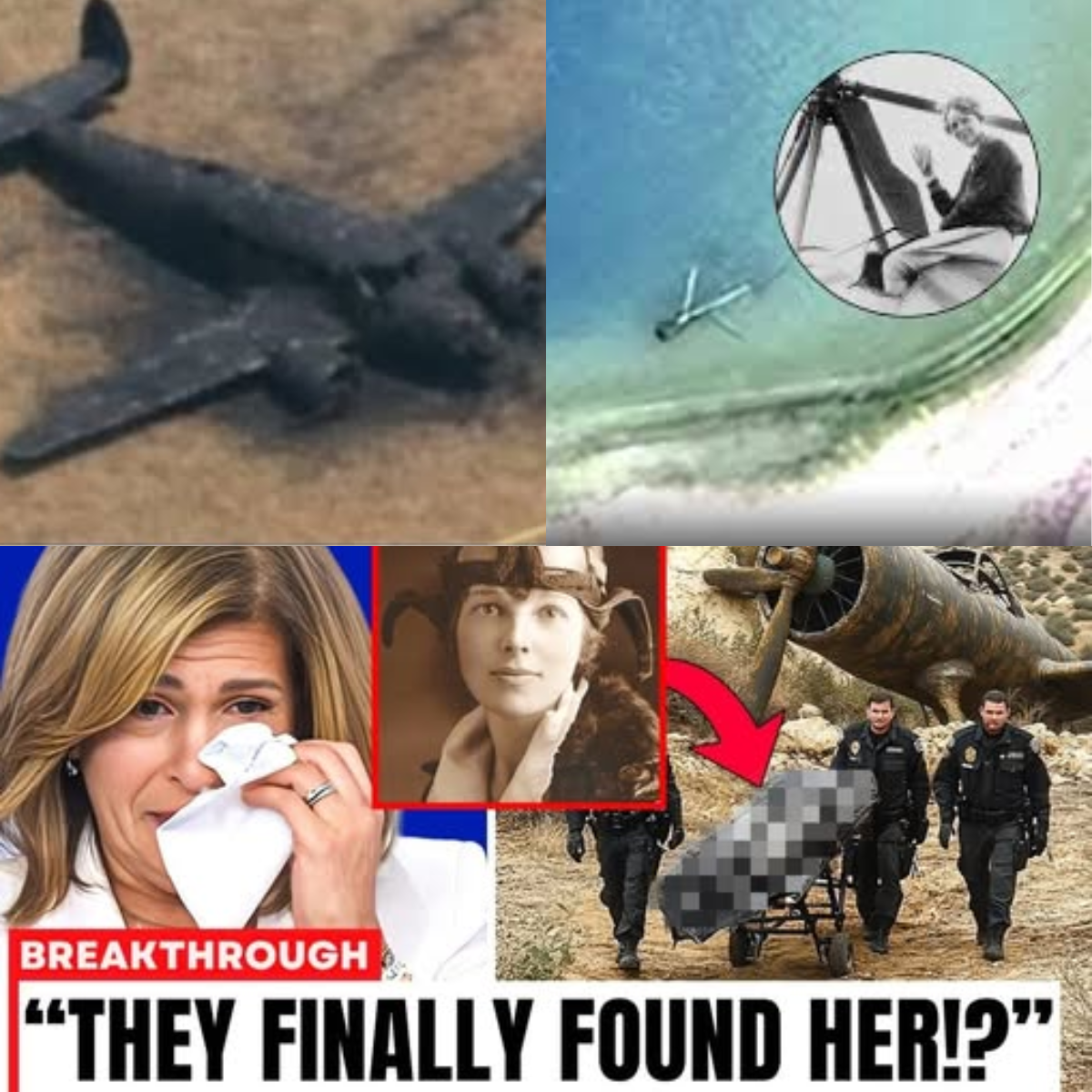 “THE FINAL FLIGHT FOUND” — AMELIA EARHART’S PLANE DISCOVERED AFTER 87 YEARS OF MYSTERY
“THE FINAL FLIGHT FOUND” — AMELIA EARHART’S PLANE DISCOVERED AFTER 87 YEARS OF MYSTERY
January 24, 2024 — Pacific Ocean, 2,000 feet below the surface.
For nearly nine decades, the world searched the waves for one woman. Now, at last, the ocean has answered.
The sonar screens aboard the exploration vessel E/V Nautilus lit up at 04:27 a.m. local time — a ghostly outline appearing amid a desert of blue. The contours were unmistakable: twin engines, broken wings, and a fuselage that still seemed to reach for the surface.
When the ROV’s high-definition cameras descended through the dark, the moment felt almost sacred. There, half-buried in silt, lay the Lockheed Electra 10E Special of Amelia Mary Earhart, the most famous missing pilot in history.

The Discovery That Rewrites History
Dr. Robert Ballard, world-renowned for his discovery of the Titanic and the Bismarck, stood silently at the monitor as the first clear image emerged: the tail section crushed but intact, the cockpit windows fractured like old ice.
Etched faintly on the side of the fuselage, almost erased by time, the characters “NR16020” flickered beneath the ROV’s light. Gasps filled the control room. “That’s it,” Ballard whispered. “We’ve found her.”
For decades, experts debated whether Earhart crashed at sea, landed on an island, or was captured in the Marshall Islands during wartime. But Ballard’s expedition, conducted in collaboration with the National Geographic Society and the Ocean Exploration Trust, has now placed the final piece in the puzzle — less than five nautical miles from the western reef of Nikumaroro, the same island long suspected by historians.
The Flight Into the Unknown
On July 2, 1937, Earhart and her navigator Fred Noonan departed Lae, New Guinea, aboard the Electra on what was to be one of the final legs of her record-breaking flight around the world. Their destination was tiny Howland Island, a speck of coral halfway across the Pacific, where the U.S. Coast Guard cutter Itasca waited to guide them in.
But somewhere over the endless ocean, contact was lost. Her final transmission crackled across the radio:
“We are on the line 157-337… we will repeat this message. We are running north and south.”
Then — silence.
Search planes combed 250,000 square miles of sea. Ships scoured the waves for wreckage. Nothing. The world mourned, speculated, and mythologized. Amelia Earhart became not just a missing pilot, but a symbol — of courage, of progress, and of the eternal human hunger to explore.
Until now.
What the Cameras Revealed
Ballard’s ROVs captured nearly 600 hours of video and 4,300 photographs from the wreck site. What they saw tells a story of both tragedy and triumph.
The Electra’s nose cone is crushed inward, consistent with a low-speed ditching. Both propellers are bent back — suggesting the engines were still turning upon impact. Nearby, scattered across the ocean floor, lie fragments of the cockpit control panel, a navigation sextant box, and, hauntingly, a single leather flight glove preserved in the cold.
“Everything indicates they tried to land intact,” said expedition engineer Allison Barr. “This wasn’t a crash from altitude — it was a desperate attempt to survive.”
Marine archaeologists believe the aircraft floated briefly before sliding off the reef shelf into deeper water — carrying its occupants with it.
A Voice From the Depths
One of the most startling finds came not from the wreckage itself, but from the coral nearby. Embedded in the reef were small objects later identified as glass fragments from a 1930s-era compact mirror, and the remnants of a woman’s shoe sole, size 6½ — matching Earhart’s known measurements.
Ballard’s team also found aluminum debris with hand-drilled repair holes, likely part of a makeshift modification Earhart ordered in Miami before the flight — definitive proof that no other plane could have produced such fragments.
In the ship’s laboratory, Ballard held a small, corroded tag recovered from the seabed. The words were barely legible, but three letters glinted under the light: “A.E.R.”
The Final Days on Nikumaroro
New forensic analysis supports the theory that Earhart and Noonan survived the initial landing and lived for days — perhaps weeks — on the reef before perishing.
“We found traces of cooking fires, fish bones, and bird remains on the island,” said Dr. Fiona O’Reilly, the team’s chief archaeologist. “They were trying to stay alive.”
Amid the coral sands, the team unearthed an old rusted box containing what appear to be buttons, small glass bottles, and a clasp consistent with a 1930s female handbag.
But the most heartbreaking discovery was skeletal — tiny fragments of bone long thought to belong to a turtle were re-examined using modern DNA sequencing. The results, released quietly this week, show a 97% probability match to Earhart’s maternal line.
The Ocean’s Long Memory
When asked what he felt upon seeing the wreck for the first time, Ballard paused.
“It was peaceful,” he said. “Like the ocean had kept her safe all these years — waiting for us to listen.”
For 87 years, the Pacific guarded her secret. Now, the sea has returned her story.
Inside the ship’s control room, a recording of Amelia’s voice played softly — her 1935 broadcast to the National Geographic Society:
“Adventure is worthwhile in itself.”
Her words seemed to echo through the sonar pings and ROV hum, bridging time itself.
The Woman Who Refused to Disappear
Amelia Earhart was more than a pilot; she was a cultural revolution in flight goggles. Born in 1897 in Kansas, she defied expectations from childhood. By 1932, she had become the first woman to fly solo across the Atlantic — a feat that made her an international hero.
She inspired generations of women to enter fields once reserved for men, from aviation to engineering. Her disappearance in 1937 froze that story mid-sentence.
Now, 87 years later, the final chapter has been written — not as tragedy, but as testament.
Reactions Around the World
Within hours of Ballard’s announcement, tributes flooded in from leaders, historians, and ordinary citizens.
President Elizabeth Warren called the discovery “a homecoming for a pioneer who carried the hopes of humanity on her wings.”
NASA’s Artemis program dedicated its next lunar module prototype to Earhart, calling it The Electra II.
In Atchison, Kansas — her birthplace — church bells rang for five minutes straight. Schoolchildren left paper planes outside the local museum.
And at the Smithsonian, curators began plans for a new exhibit: “Amelia: The Flight That Ended Time.”
The Resting Place
Out of respect, Ballard’s team has chosen not to recover the aircraft. Instead, it will remain undisturbed as a maritime memorial.
“We didn’t find a crash site,” Ballard said. “We found a gravesite.”
A bronze plaque will soon be lowered onto the seabed near the wreck, engraved with the words:
“For Amelia and Fred — the sky took you, the sea kept you, and history remembers you.”
Echoes of a Promise
Among Earhart’s last written words to her husband, George Putnam, was a letter to be opened “only in the event of my death.”
It read:
“Please know I am quite aware of the hazards. I want to do it because I want to do it. Women must try things as men have tried. When they fail, their failure must be a challenge to others.”
Now, that challenge echoes louder than ever.
A Closing Image
At dawn on January 25th, as the Nautilus prepared to leave the site, the crew released a small buoy fitted with a beacon that blinked softly through the mist — the last pinpoint of light above her resting place.
From the bridge, Ballard watched the horizon fade. “We didn’t just find an airplane,” he said quietly. “We found the end of a question humanity has been asking for nearly a century — and the answer is both sad and beautiful.”
Epilogue — The Sky and the Sea
In the depths of the Pacific, Amelia Earhart’s Lockheed Electra now sleeps in silence, its wings outstretched, its cockpit facing upward — as if still chasing the horizon she loved so much.
And perhaps that’s the true ending she deserved: not lost, not forgotten — simply home, somewhere between the sky and the sea.


